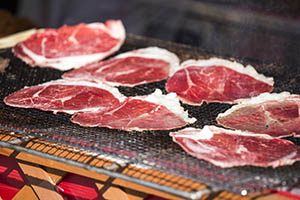
What is Paleo? In 2002, Loren Cordain, a professor from Colorado State University published a book based on his research of our caveman ancestor’s diets, called “The Paleo Diet”. Although there is no way to definitely know what caveman ate, research has made some educated guesses based on the idea that cavemen were opportunists and would have eaten any kind of fruit, grain, or sugar available. Most importantly, a Paleo-based diet eliminates processed foods – as they obviously didn’t exist at that time. Meals are instead, made up from a combination of non-starchy veggies, high-quality animal proteins like grass-fed steak or pastured eggs, and healthy fats like coconut oil and avocados.
But, how do you make sense of that a Paleo diet should look like? Think of it as a pyramid. The base of your pyramid are the items that should make up the bulk of your food choices, while the items at the top of the pyramid are those items you can add to your diet in small quantities. One thing to keep in mind is that how much you should eat in total varies based on the food group, the types of food within that group, and how it should be prepared – so you may want to do a bit more research or talk to a dietician to figure out the best serving size for your diet and fitness needs.
In general, though, this is how the pyramid should look:
Lots of plant based foods make up the base of the Paleo pyramid:
Think green. Spinach, kale, broccoli, bell peppers, asparagus – if it’s green, it’s good. You’ll want to avoid starches like potatoes. Shoot for 2-3 servings per meal. The best part – don’t worry about getting too much – if you’re hungry, and need a bigger meal, adding more greens to your meal is a great way to satisfy your hunger, without adding too many calories.
You’ll also want to eat plenty of protein
This is the next level on your Paleo pyramid. And, you can get it from eggs, steak, chicken, or bacon. And, if you can find grass-fed beef, free-range chicken, or pastured eggs, you’ll be eliminated growth hormones and antibiotics that aren’t that healthy for you either. Shoot for about 25 grams of protein per serving.
Fats are important – but only healthy fats
The next level on the Paleo pyramid are fats. You’ll want to get your fats from healthy fat sources such as avocados, nuts, coconut oil, and grass-fed butter. You’ll want to shoot for one serving per meal of healthy fats.
Along with healthy fats, you’ll want nourishing foods as well.
What are “nourishing foods?” These are foods that heal your guts and your body – stuff like kimchi, sauerkraut, and kefir. You can also add bone broth to the list. You can substitute a serving of nourishing foods for a serving of healthy fats for one or two of your meals per day.
Small amounts of dairy and grains
You don’t want to eliminate grains and dairy from your Paleo diet – but you want to keep them at a minimal level. Fruit, sweet potato, and natural sugars give you some healthy, slow-burning carbs for extra energy without causing your body to store them as fat. Depending on your level of exercise, one to three servings per day (the more you exercise, the more you can add to your diet for extra energy for your workouts).
Have a little fun with wine and chocolate
One of the hardest things about any diet is so many diets eliminate those foods that allow you to enjoy life. With the Paleo diet, if you limit your wine consumption to 1-3 glasses per week, and a couple of squares of sugar free dark chocolate, you can still have some enjoyment in your diet as well!

